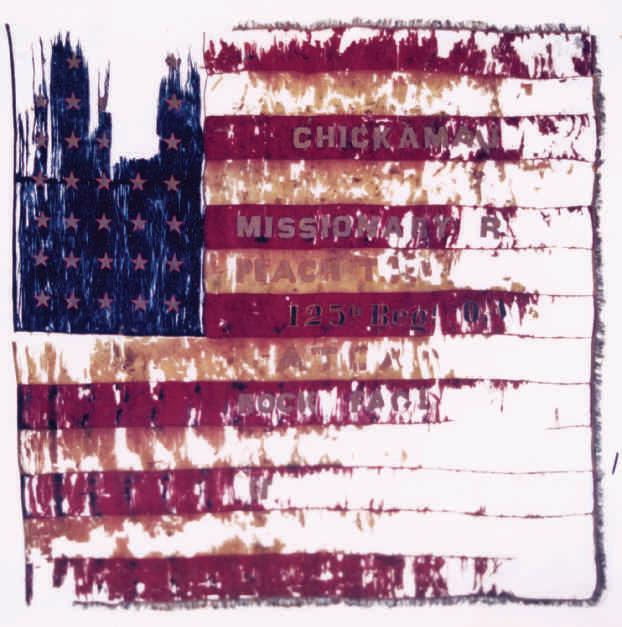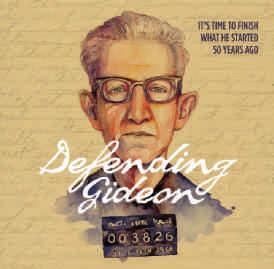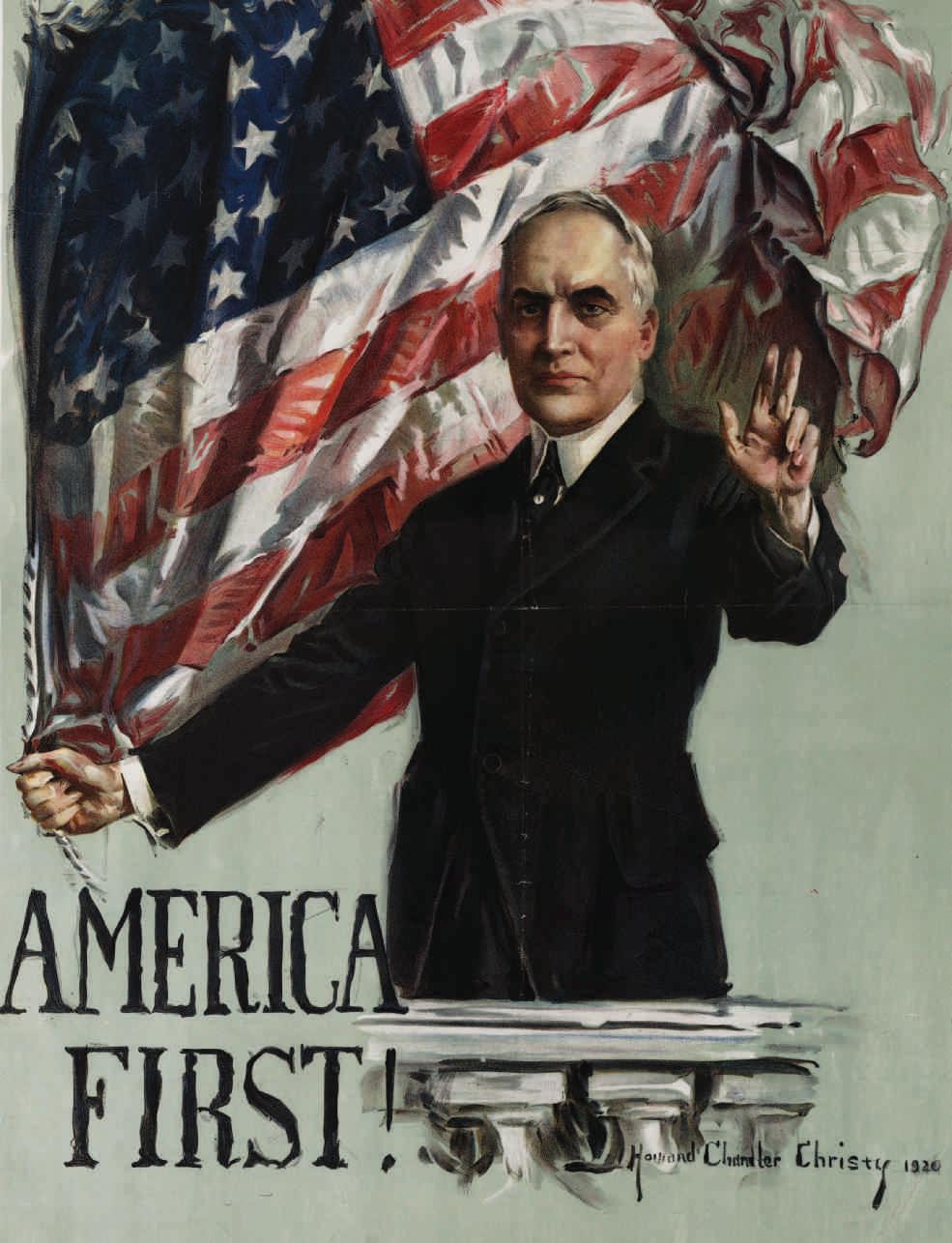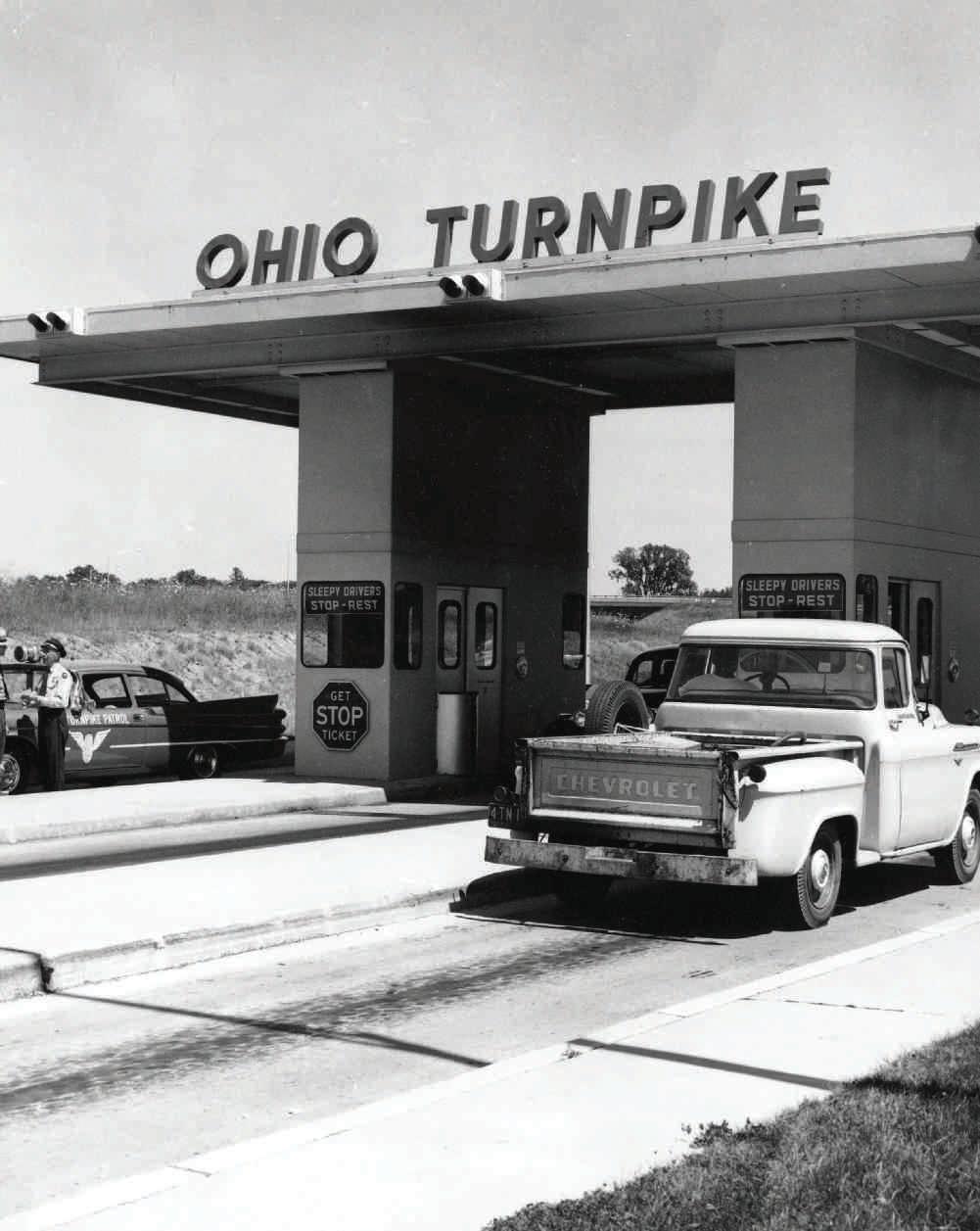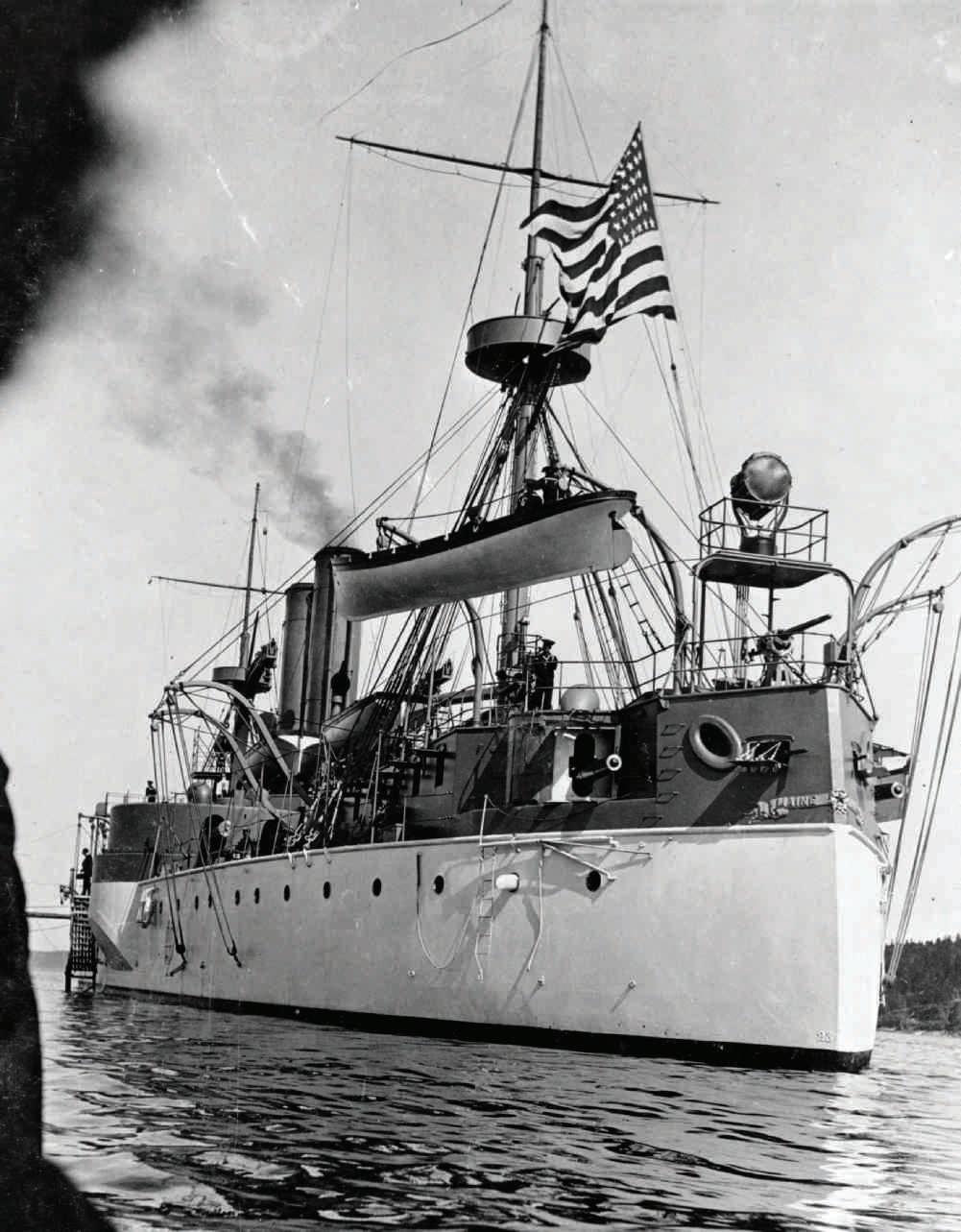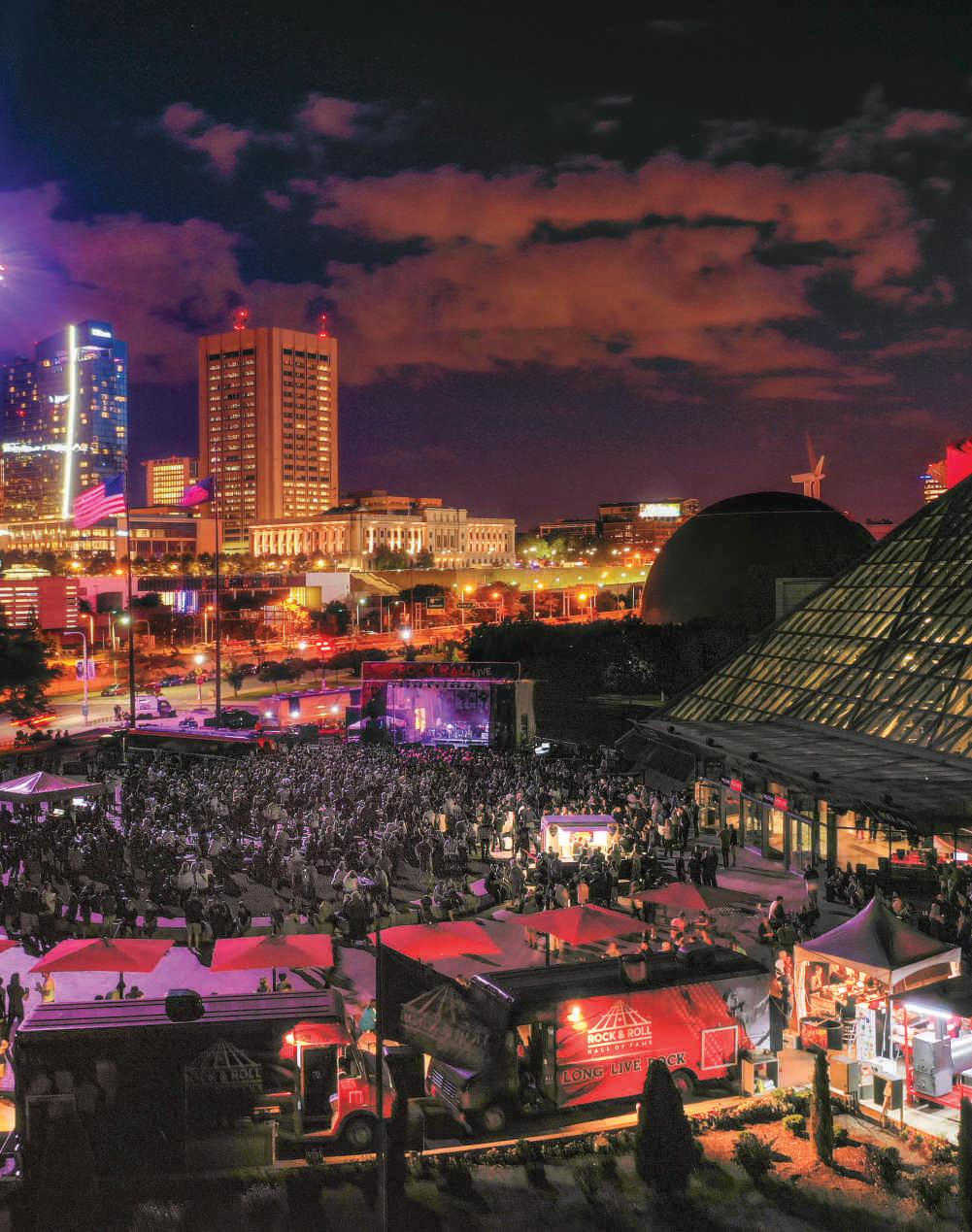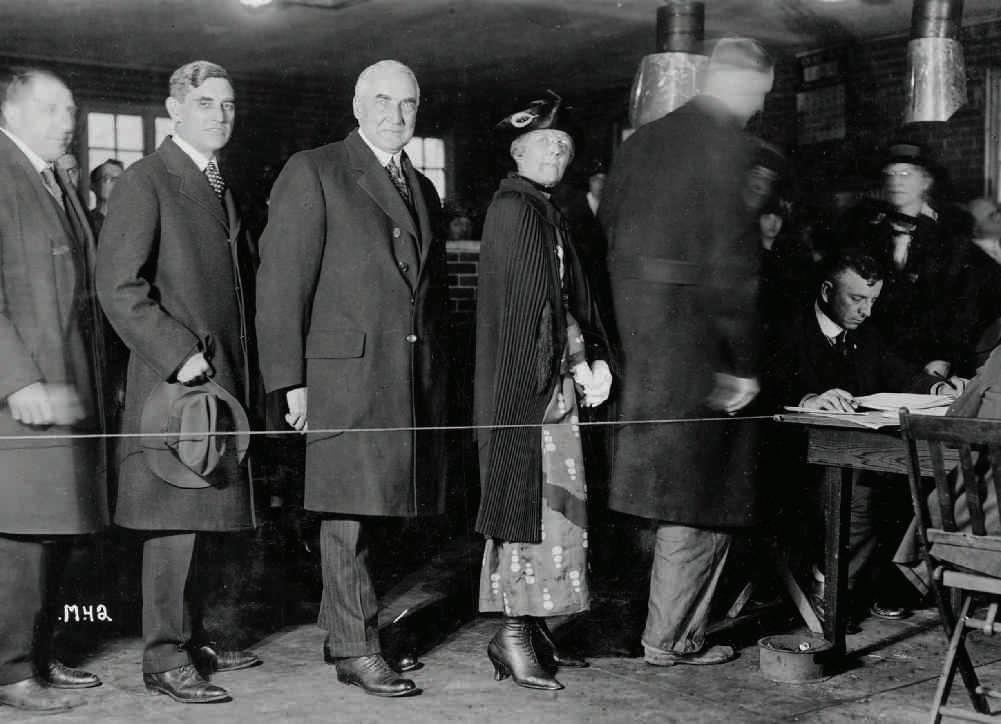
27 minute read
In the News
What has become today’s National Football League was “born” in Ohio a century ago this fall. Visiting Canton or Dayton? Check out these Ohio Historical Markers.
THE CRADLE OF PROFESSIONAL FOOTBALL Near Pro Football Hall of Fame, 2121 George Halas Dr., N.W., Canton On September 17, 1920, representatives from ten professional football teams met in Canton and formed the American Professional Football Association, which in 1922 became the National Football League (NFL). Pro football evolved from club football in the 1890s, and by the early 1900s had begun to spread across the country, concentrating in the Midwest. Jim Thorpe, the first nationally prominent pro, started with the Canton Bulldogs—an early pro football power—in 1915. In 1959, Canton citizens launched a wellorganized and ultimately successful effort to have their city, “the cradle of professional football,” designated as the site of a monument to the sport’s historic stars. The Professional Football Hall of Fame opened on September 7, 1963, inducting seventeen charter members. The Hall of Fame interprets and promotes the study of the role of professional football in American culture.
SITE OF FIRST GAME IN THE NFL Along the walkway between the parking lot and Howell Field at Triangle Park, 2860 Ridge Ave., Dayton On October 3, 1920, the first game matching two professional teams of the American Professional Football Association, a league that would become the National Football League (NFL), was held on this field within Triangle Park. In that game, the Dayton Triangles defeated the Columbus Panhandles 14–0. The Triangles’ Lou Partlow scored the first touchdown and George “Hobby” Kinderdine kicked the first extra point. Three factories founded by Dayton businessmen Edward Deeds and Charles Kettering sponsored the Dayton Triangles team. The factories were the Dayton Engineering Laboratories Company (DELCO), Dayton Metal Products Company (D.M.P.Co.), and Domestic Engineering Company (DECO), later called Delco-Light. They formed an industrial triangle of plants in downtown Dayton. Explore Ohio Historical Markers throughout the Buckeye State at remarkableohio.org.
OHIO HISTORICAL MARKERS Remarkable Ohio
The Ohio History Connection's familiar brown-and-gold Ohio Historical Markers dot the Buckeye State. No doubt you've spotted one or more on your travels. Maybe there's even one near your home. Have you ever wondered where they all are or what they all say? You can see them all by traveling no farther than Remarkable Ohio, a website that features all of the Ohio Historical Markers, where they're located, what they say and pictures most, some with additional photos. Sort by county (plan you own driving tour) or by a topic of interest to you, or just browse and enjoy the amazing Ohio stories they share! Find Remarkable Ohio at remarkableohio.org.

HISTORIC PRESERVATION Landmark Theatres Open Doors Online Sept. 11–20
Discover Ohio’s amazing heritage as historic theatres across our state host special online tours and virtual events during Ohio Open Doors, Fri., Sept. 11, through Sun., Sept. 20.
BEHIND-THE-SCENES LOOKS
From Victorian-era opera houses still in use today to opulent movie palaces of the 1920s restored to present live entertainment in communities all across our state, you can explore fascinating venues that reflect Ohio’s rich heritage in the performing arts. Many are offering behind-the-scenes looks online that aren’t ordinarily available. All online Ohio Open Doors events are free, and most are special one-day-only opportunities. The Ohio History Connection created Ohio Open Doors in 2016 to promote and inspire pride in Ohio’s heritage and to celebrate the 50th anniversary of the National Historic Preservation Act.
Signed by President Lyndon B. Johnson on Oct. 15, 1966, the Act has proven instrumental in transforming the face of communities from coast to coast, establishing the legal framework and incentives to preserve historic buildings, landscapes and archaeological sites. It drives economic revitalization by attracting investment, supporting small business, stabilizing neighborhoods and creating jobs. ”Ohio Open Doors shares stories of important landmarks right in our backyard, highlighting the history and unique nature of some of Ohio’s most treasured historic places,” says Burt Logan, executive director and CEO of the Ohio History Connection.
MANY IN NATIONAL REGISTER
The Ohio History Connection’s State Historic Preservation Office administers the National Historic Preservation Act in Ohio. Many of the landmarks featured in Ohio Open Doors events are in the National Register of Historic Places, which the National Historic Preservation Act created.
Ohio Open Doors is cosponsored by partnering organizations in communities across the Buckeye State.
Find Ohio Open Doors virtual events at ohiohistory.org/ opendoors starting Fri., Sept. 11. Learn more about the Ohio History Connection’s State Historic Preservation Office at ohiohistory. org/shpo. Murphy Theatre, Wilmington

TRAVEL
Ohio Literary Trail
The Ohioana Library Association’s new Ohio Literary Trail shines a spotlight on Ohio’s role in shaping culture and literature worldwide. Discover our state’s rich literary landscape through landmark destinations, Ohio Historical Markers that recognize literary achievements, and book festivals dedicated to readers and writers. The trail is organized by geographic regions for convenient selfguided driving tours. Learn more at ohioana.org.
Subscribe to our free weekly enews for current information and updates from the Ohio History Connection. Sign up at
ohiohistory.org/enews.
OCTAGON EARTHWORKS Ohio Supreme Court Will Hear Octagon Earthworks Appeal
On Tues., July 7, the Ohio Supreme Court announced that it would hear an appeal by Newark’s Moundbuilders Country Club regarding the Octagon Earthworks lease. Oral arguments will be presented before all seven justices. At this time, the precise schedule is unknown.
TO ENSURE FULL PUBLIC ACCESS
Our guiding principles throughout this process have been to ensure full public access to Octagon Earthworks, while also ensuring that Moundbuilders Country Club receives just compensation for the value of the lease. We are unwavering in our belief that the Octagon Earthworks must be accessible to all. This position has been affirmed by the Licking County Common Pleas Court and upheld by the Fifth District Court of Appeals, and we look forward to making our case to the Ohio Supreme Court. On Jan. 29, 2020, Ohio’s Fifth District Court of Appeals unanimously affirmed Licking County Common Pleas Judge David Branstool’s ruling that the Ohio History Connection has the authority to acquire the lease at the Octagon Earthworks, and that the acquisition is both necessary and for a public purpose. After the ruling, Moundbuilders Country Club filed notice with the Ohio Supreme Court that it intended to appeal the finding by the Fifth District Court. Citing the club’s pending appeal, Judge Branstool postponed the jury trial that will determine the value of the lease until after the Ohio Supreme Court returns the case to Licking County Common Pleas Court, which could take up to a year or more. Part of the Newark Earthworks, remnants of a 2,000-year-old complex that’s the largest set of geometric earthworks ever known, Octagon Earthworks encloses 50 acres and has eight walls, each measuring about 550 feet long and from five to six feet high. It’s a National Historic Landmark and Ohio’s official prehistoric monument. The Newark Earthworks served social, ceremonial and astronomical functions for American Indians of the ancient Hopewell Culture who built them. The Ohio History Connection has owned Octagon Earthworks since 1933. Moundbuilders Country Club holds a long-term lease on the site that would not expire until 2078. The Ohio History Connection is seeking to acquire the lease to make the Octagon Earthworks fully accessible to the public in association with the nomination of Ohio’s ancient Hopewell Ceremonial Earthworks for inscription on UNESCO’s World Heritage List. As we move forward in our ongoing effort to make the Octagon Earthworks fully accessible to all, we will continue to provide you with regular updates on our progress.
LEARN MORE
For more information, visit ohiohistory.org/octagon. Learn more about the nomination of Ohio’s Hopewell Ceremonial Earthworks, including Octagon Earthworks, for designation as a World Heritage Site at worldheritageohio.org. Explore the Octagon Earthworks during a special open house on Sun., Oct. 18. See page 19.

HISTORY DAY National Results Are In
Sat., June 20, concluded the barrier-breaking 2020 National History Day contest year. “From holding a few in-person contests, then quickly switching to a virtual platform, this year has shown just how important history is—and how Ohio’s students rose to the challenge to share their impressive research,” says Samantha Rubino, the Ohio History Connection’s state coordinator for Ohio History Day “In total, we had over 6,500 students participate in the program and over 1,700 compete in Ohio History Day regional and state contests,” she says. “Of those, 63 went on to the National History Day contest, which took place virtually from June 14th to 20th.”
FOUR OHIO STUDENTS PLACE IN TOP 10
In the National History Day competition, Ohio had four entries place in the top 10 of the documentary, paper and website categories. Two of those were in the top three: second place in Senior Paper and second place in Senior Individual Documentary. “Regardless of where Ohio’s students placed in the contest, we are extremely proud of their hard
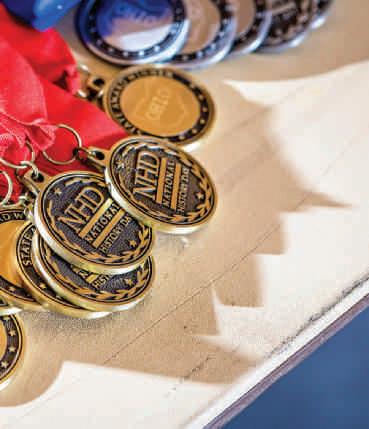
work, perseverance and incredible historical research during an unprecedented year,” Rubino says. For more about this year’s contest and to watch the virtual awards ceremony, visit nhd.org/ virtual2020.
HISTORY DAY 2021 GETS UNDERWAY
As one contest year comes to a close, another contest year begins. The 2021 National History Day theme is Communication in History: The Key to Understanding. Visit ohiohistoryday.org and click on “Contest Information” to learn more about the 2021 National History Day theme and find the Ohio History Day theme sheet and topic guide. To see a list of Ohio’s 2020 National History Day finalists, visit ohiohistoryday.org and click on “Contest Information” then “National Contest”. North Bass School
HISTORIC PRESERVATION Recent Ohio Additions to the National Register of Historic Places
ISLE ST. GEORGE • OTTAWA COUNTY NORTH BASS SCHOOL 515 Kenny Rd.
North Bass School is associated with the history of education in Isle St. George, North Bass Island and the Lake Erie islands. The 1952 building is called a teacherage, which is a purpose-built one-room school with a residence for the teacher. North Bass School was in continuous operation until 2005, when the last students on North Bass Island moved to high school at Put-in-Bay on South Bass Island. The North Bass Local School District was the last to operate a one-room school in Ohio.
Courtesy State Historic Preservation Office

PAINESVILLE • LAKE COUNTY
DOWNTOWN PAINESVILLE HISTORIC DISTRICT Veterans Park, 22 Liberty St., 7 Richmond St., 7–71 N. Park Pl., 30–100 S. Park Pl., 15–34 S. St. Clair St., 105–270 Main St., excluding 177 Main St., 8–124 N. State St., 1–83 S. State St., excluding 54 S. State St.
The Downtown Painesville Historic District is associated with the history of commerce and government in Painesville. The district includes the 1909 Lake County Courthouse designed by Cleveland architect J. Milton Dyer in a style called Beaux Arts Classicism, a major influence on American architecture at the time. Other buildings in the district date from 1838, when the oldest one was constructed (currently one of the Joughin Hardware buildings) through 1967, when the Key Bank building at the corner of Main and State streets was completed.

Rankin House, Ripley
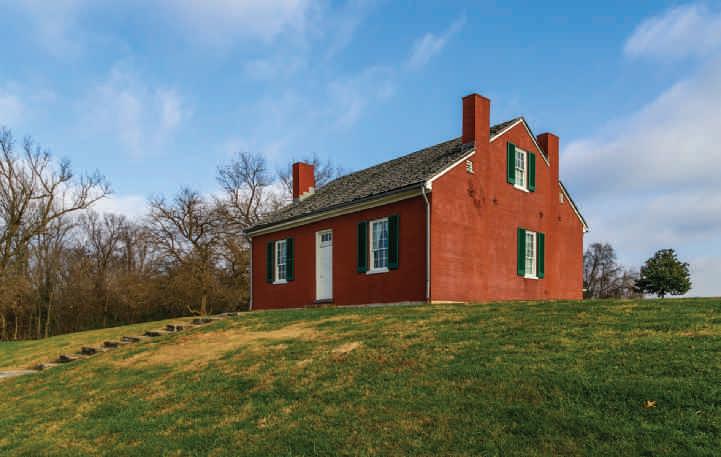
OHIO HEROES John P. Parker and John Rankin
Ripley, Ohio, faces Kentucky from the north bank of the Ohio River in Brown County, east of Cincinnati. In the years before the Civil War, Ripley was a point of entry to Ohio’s Underground Railroad—a loose-knit network of “conductors” and other allies for fugitives from slavery on their way North. Many early citizens of Ripley were involved in this covert activity, and as such are rightly regarded as heroes. Among them, two in particular, one black and one white, stand out.
JOHN P. PARKER
John Parker was an active participant in the Underground Railroad in Ohio and helped fugitives from slavery escape to freedom in the years before the American Civil War.
Parker was born on Feb. 2, 1827, in Norfolk, Virginia. His mother was enslaved and his father was a free white man. When John Parker was eight years old, he was sold to a doctor in Mobile, Alabama, who taught him to read and write. Many states had laws prohibiting the education of slaves. Many slaveholders believed that education would encourage slaves to run away as they became more knowledgeable about the world around them. An educated slave also removed a primary justification slaveholders often cited for slavery—that African Americans supposedly were incapable of becoming educated. Nevertheless, the doctor allowed Parker to become educated and apprentice at a local iron foundry. Later, Parker was held in slavery by one of the doctor’s patients. When Parker was 18 years old, he purchased his freedom with money that he earned while working at the foundry. Parker eventually moved to the North. He briefly worked in Indiana and in Cincinnati at several iron foundries. In 1848, Parker established a general store at Beachwood Factory, Ohio. In 1850, he settled in Ripley along the Ohio River. There, he opened his own foundry. He also became active in the Underground Railroad. Parker commonly traveled across the Ohio River to Kentucky to help fugitives escape to the North. He routinely took them to John Rankin, another abolitionist who lived in Ripley, who John Parker House, Ripley

hid them and assisted them in their journey. During the Civil War, Parker served as a recruiter for the 27th Regiment, U.S. Colored Troops. With the ratification of the 13th Amendment to the United States Constitution and the end of slavery in 1865, Parker devoted his energies to his foundry business. Over the course of his life, Parker was the owner or president of the Ripley Foundry and Machine Co. and the Phoenix Foundry. Parker died on Jan. 30, 1900. There is no known photograph of John P. Parker.
JOHN RANKIN
John Rankin was a Presbyterian minister and a prominent member of the Underground Railroad network which aided fugitives from slavery in the years before the Civil War. Rankin was born on Feb. 4, 1793, in Tennessee. He attended Washington College in Virginia and became a minister in the Presbyterian Church. Rankin dedicated his life to abolishing slavery in America. In 1818, Rankin formed an antislavery society in Carlisle, Kentucky. Slavery was legal in Kentucky, and Rankin
John P. Parker Historical Society

was criticized for his views. He eventually moved to Ripley. Slavery was illegal in Ohio. While many Ohioans opposed the ending of slavery, the people of the state were generally more receptive to abolitionists than their neighbors in Kentucky. In Ripley, Rankin served as a “conductor” on the Underground Railroad and opened his home to African Americans seeking freedom. His home stood on a 300-foot-high hill that overlooked the Ohio River. Rankin would signal fugitives in Kentucky with a lantern, letting them know when it was safe to cross the river. He kept them hidden until it was safe for them to travel farther north. The United States Constitution and the Fugitive Slave Law of 1850 permitted slaveholders to reclaim fugitives, even in a free state like Ohio. To truly gain their freedom, they had to leave the United States. Underground Railroad stops provided fugitives with safe houses all the way to Canada. Rankin gave shelter and food to as many as 2,000 freedom seekers during his career with the Underground Railroad. Harriet Beecher Stowe immortalized Rankin’s efforts in her
Ohio History Connection Archival Collections

John and Jane Rankin
book, Uncle Tom’s Cabin. Rankin’s home was the first stop in Ohio for Eliza, one of the book’s main characters, as she sought freedom in the North.
Rankin spent most of his life in Ohio as a Presbyterian minister. He helped establish the Free Presbyterian Church of America, which prohibited slaveholders from becoming members. Rankin also helped form an antislavery society in New York and established the Ohio Anti-Slavery Society in 1835. In 1829, he established Ripley College. At its peak, the college had 250 students. In 1831, Rankin enrolled the first African American student in the school. Many of the college’s students came from Kentucky and did not share Rankin’s abolitionist views. Some students left Ripley College and did not return. Rankin also lectured across the North for the American AntiSlavery Society. He was often the victim of mob violence. Rankin died on March 18, 1886, in Ironton, Ohio. These biographies are based on those in Ohio History Central, our online encyclopedia of Ohio history. Discover many more great Ohioans and many more stories of Ohio history at ohiohistorycentral.org.
LEARN MORE
Beyond the River: The Untold Story of the Heroes of the Underground Railroad, by Ann Hagedorn, shares the story of Ripley and its underground activity. His Promised Land: The Autobiography of John P. Parker, Former Slave and Conductor on the Underground Railroad, edited by Stuart Seely Sprague, is John Parker’s story as transcribed by a reporter in the 1880s. Visit the riverfront home of John Parker and hilltop home of John Rankin, both now museums and National Historic Landmarks, the highest designation awarded to historic places by the United States. Much of the old river town of Ripley is a historic district listed in the National Register of Historic Places. Find more about visiting the Parker House on the John P. Parker House Facebook page or at johnparkerhouse.net. Learn more about visiting the Rankin House at ohiohistory.org/rankin. You may also enjoy the National Park Service travel itinerary Aboard the Underground Railroad at nps. gov/nr/travel/underground.
LOCAL HISTORY Ohio Local History Alliance Meets Oct. 1–3 Online
“When the Ohio Local History Alliance Education Committee picked History is Happening Now as the theme for our 2020 conference, we never expected that it would be quite so on-the-nose,” says Ohio Local History Alliance Executive Secretary Betsy Hedler. “Since mid-March, it’s been impossible to ignore that we’re living through one of those moments that historians will study, write and create exhibits about. From the global pandemic to the ongoing protests against police brutality and systemic racism, much that we once took for granted has changed or been challenged.” The Ohio Local History Alliance Annual Meeting will be held this year on the scheduled dates, Oct. 1–3. However, due to the ongoing pandemic and its effect on the finances of Ohio Local History Alliance members and member organizations, Hedler says the Annual Meeting will be held virtually this year.
NETWORK WITH LOCAL HISTORIANS
The online Annual Meeting will include social time to network with fellow Ohioans active in local history, presentation of this year’s Outstanding Achievement Awards and lots of great sessions on topics ranging from creating video tours to self-guided tours at house museums and from how to research a historic house to reacting to a disaster in collections storage—and beyond. The conference theme was chosen to encourage local historians to think about the relevance of local history organizations in Ohio communities, and ways to work collaboratively on a historical narrative that includes everyone in

Melanie A. Adams
the community. There is a thread of these sessions running through the conference, including presentations on African-American community archives, working with American Indian communities, oral history projects, women’s history, working with youth volunteers and a collaborative discussion, “Relevance in a World with Bigger Problems.”
SMITHSONIAN’S ANACOSTIA MUSEUM DIRECTOR KEYNOTES
To keynote, the Ohio Local History Alliance will welcome Melanie A. Adams of the Anacostia Community Museum as this year’s plenary speaker, sponsored by Ohio Humanities. Adams became director of the Smithsonian’s Anacostia Community Museum in 2019. She previously served as deputy director of learning initiatives at the Minnesota Historical Society. With more than 25 years of community engagement experience in museums and higher education, Adams is dedicated to bringing stakeholders together to address community issues. From 2016 to 2019, she led efforts at the Minnesota Historical Society to develop strategic partnerships, audiences and resources within local communities. Prior to her time at the Minnesota Historical Society, she was managing director of the Missouri Historical Society for 11 years. In that role, she addressed the social and cultural concerns of the St. Louis community and oversaw more than 700 community programs each year, including events with more than 100 partners. Adams was president of the Association of Midwest Museums from 2014 to 2016 and currently serves on the board of the American Association for State and Local History.

LEARN MORE AND REGISTER
To learn more about the Ohio Local History Alliance Annual Meeting and register, visit the Ohio Local History Alliance website, ohiolha.org, or email ohiolha@ohiohistory.org.
Ohio History Connection members have elected two new trustees, Jen Miller of Columbus, and Melody Young of Laurelville. Each will serve a three-year term.
JEN MILLER
Miller has extensive experience in nonprofit leadership, public engagement and cultural programming. She began her career as an intern at the Native American Indian Center of Central Ohio. At Music in the Air, she produced outdoor concerts and festivals, such as Short North Sunday, the Jazz, Rhythm and Food Festival and Festival Latino. While with the King Arts Complex, Miller produced programs to explore issues such as domestic violence, AIDS/HIV and racial stereotypes in popular culture. She has also served as chapter director of Sierra Club Ohio, where she worked for public land, water and air protections. Currently, she serves as executive director of the League of Women Voters of Ohio, educating Ohioans on civics and electoral participation. Miller has a master’s degree in arts administration, education and policy, and a degree from The Ohio State University John Glenn College of Public Affairs. While at Ohio State, she was a University Fellow and published research in several national and international peerreviewed academic journals on the need for cultural institutions to address issues of social justice. She has bachelor’s degrees from Capital University in vocal music and history, with a minor in ethnic studies. Young has 25 years of experience in the hospitality industry and has held a variety of management roles in Ross, Fairfield, Hocking and Franklin counties. Her areas of expertise are in guest services, human resource management, sales and facilities operations. In her current role as director of the Ross-Chillicothe Convention and Visitors Bureau, Young works to make Ross County a premier tourism destination.
She serves on a number of boards in the Ross County area that include the Tecumseh Outdoor Drama, Majestic Theatre, Ohio’s Appalachian Country, Ross County Convention Facilities Authority, Kiwanis and the World Heritage Ohio Steering Committee. Leaving the Ohio History Connection board are James A. Wilson of Bexley, who served from 2011 to 2020, and Nancy Shaw Goldsmith of Shaker Heights, who served from 2019 to 2020.
2020–2021 OFFICERS
The board has elected the following officers for the coming year: Thomas V. Chema of Westlake, President; James F. Dicke II of New Bremen, Vice President; Elizabeth A. Weibel of Chagrin Falls, Vice President; Suhas Kakde of Dayton, Treasurer; and Charles R. Moses of Dublin, Secretary. Additional trustees include C. Ellen Connally, Cleveland; Loann W. Crane, Columbus; Jon T. Elsasser, Zoar; Chief Billy W. Friend, Wyandotte, Oklahoma; James B. Hadden, Columbus; Alex Hastie, Grandview Heights; Richard F. Hillis, Powell; Robert W. Lucas, Pemberville; Charles R. Moses, Dublin; Michael G. Rapp, Blue Ash; Robert M. Roach, Upper Arlington; and Gregory H. Simpson, Milford.
OHIO HISTORY CONNECTION
It’s Official
Since 2014, we’ve been doing business as the Ohio History Connection. In June, Ohio History Connection members voted to make it legal, allowing us to bring contracts, legal documents and some other places where we were still required to go by Ohio Historical Society in line with our new name, Ohio History Connection. Thanks for your approval of this small change, which allows us to go by Ohio History Connection in everything we do.

GENEALOGY WORKSHOPS
NOW ONLINE ATTEND FROM ANYWHERE!
Find our full 2020 schedule and register online at ohiohistory.org/genealogy
OHIO HISTORY SERVICE CORPS Ten Begin Year of Service
Starting in mid-September, 10 new AmeriCorps members will be taking part in the Ohio History Connection’s Ohio History Service Corps in the Athens, Cincinnati, Cleveland, Columbus, Oberlin, Portsmouth, Warren, Wauseon and Youngstown areas. Their year of service is made possible by a $152,903 grant from Ohio’s commission on service and volunteerism, ServeOhio. Launched in 2010, the Ohio History Service Corps is one of just two history-related Americorps programs in the country. Participants serve for one year to help meet local history- and preservation-related needs, compiling information about historic places and architectural landmarks, organizing and digitizing museum collections, promoting professional standards and best practices and building the capacity of history-related organizations. For the 2020–2021 service year, the Ohio History Connection is one of 26 organizations receiving a total of $8.8 million in AmeriCorps funding to Ohio.
Nationwide, AmeriCorps programs involve more than 80,000 people in service each year through more than 21,600 organizations. Members receive a living allowance and those who complete 1,700 hours of service earn a $6,095 Segal AmeriCorps Education Award to help pay for college or pay back student loans. Since 1994, more than 1 million men and women have served in AmeriCorps, providing more than 1.4 billion hours of service and earning more than $3.3 billion in scholarships, more than $1 billion of which has been used to pay back student loan debt.
Learn more at ohiohistory.org/ americorps, serveohio.org and nationalservice.gov.
MAKE NEW FRIENDS Become Part of Conestoga’s History
Now’s a great time to join Conestoga, the Ohio History Connection’s volunteer fundraising support group. Since 1986, Conestoga members have raised more than $700,000 to support Ohio History Connection initiatives in Columbus and across the state.
As a Conestoga member, in addition to enjoying all the benefits of Ohio History Connection membership, you'll also enjoy free programs tailored especially for Conestoga members. This year’s programs include a mix of virtual and socially distanced in-person events, as well as a book club and tours of outdoor sites. Conestoga membership includes a one-year membership in the North American Reciprocal Museum Association, giving you free member admission at more than 1,000 museums across North America.
Join Conestoga today and make new friends, connect more closely with Ohio history and become part of a group of people who share a deep appreciation for Ohio’s rich history and the well-being of the Ohio History Connection as its steward. For more information and a list of this year’s activities, visit ohiohistory.org/conestoga or contact Truda Shinker of the Ohio History Connection’s Development Office at 614.297.2334 or tshinker@ohiohistory.org.
presents
SLEEPY HOLLOW
FRI., OCT. 2, 9, 16, 23 & 30 5 & 8:30 P.M. OHIO HISTORY CENTER COLUMBUS See a different spooktacular movie every Friday night in October, plus drive-thru scenes in the spirit of All Hallows’ Eve.
OCTOBER • ONLINE— ATTEND FROM ANYWHERE! Explore the spooky (but-not-toospooky) world of Ohio Village on All Hallows’ Eve and hear The Legend of Sleepy Hollow.
SAT., OCT. 3 • 7–8:30 P.M. ONLINE—ATTEND FROM ANYWHERE! 21+? Enjoy an autumn mix of Halloween cocktails (we’ll teach you how to make them) and haunting Ohio ghost tales.
OHIO HISTORY CONNECTION
Historic Sites & Museums
NORTHWEST OHIO
1. 2. 3. 4. 5. 6. 7. 8. 9. 10. 11. 12. 13. 14.

Armstrong Air & Space Museum Cedar Bog Nature Preserve Cooke-Dorn House Fallen Timbers Battlefield Memorial Park Fort Amanda Memorial Park Fort Jefferson Memorial Park Fort Meigs Fort Recovery Museum & Monument Glacial Grooves Geological Preserve Hayes Presidential Library & Museums Indian Mill Inscription Rock Petroglyphs Johnston Farm & Indian Agency Lockington Locks
NORTHEAST OHIO
15. 16. 17. 18. 19. 20. 21. 22. 23.
24. Custer Monument Fort Laurens McCook House Museum of Ceramics Quaker Yearly Meeting House Schoenbrunn Village Shaker Historical Museum Tallmadge Church Youngstown Historical Center of Industry & Labor Zoar Village
CENTRAL OHIO
25.
26. 27. 28. 29. 30. 31. 32. Flint Ridge Ancient Quarries & Nature Preserve Hanby House Logan Elm Newark Earthworks Ohio History Center & Ohio Village Shrum Mound Wahkeena Nature Preserve Warren G. Harding Home & Memorial
SOUTHWEST OHIO
33. Adena Mansion & Gardens 34. Davis Memorial Nature Preserve 35. Fort Ancient Earthworks & Nature Preserve 36. Fort Hill Earthworks & Nature Preserve 37. Harriet Beecher Stowe House 38. John Rankin House 39. Miamisburg Mound 40. National Afro-American
Museum & Cultural Center 41. Paul Laurence Dunbar House 42. Serpent Mound 43. Story Mound 44. U.S. Grant Birthplace 45. U.S. Grant Boyhood Home & Schoolhouse 46. William Henry Harrison Tomb
SOUTHEAST OHIO
47. 48. 49. 50. 51. 52. 53. 54. 55. Big Bottom Memorial Park Buckeye Furnace Buffington Island Battlefield Memorial Park Campus Martius Museum John & Annie Glenn Museum Leo Petroglyphs & Nature Preserve National Road & Zane Grey Museum Ohio River Museum Our House Tavern
P RO G R A M S & E X H I B I T S AT T H E Ohio History Center & Ohio Village
Due to the COVID-19 pandemic, most Ohio History Center & Ohio Village programs have moved online. See pages 17–18. Before traveling to visit the Ohio History Center & Ohio Village, we recommend that you first visit ohiohistory.org/sites or call 800.686.6124 to confirm hours and any special requirements.
All Ohio History Center & Ohio Village programs and events currently require advance registration. To register or confirm that a specific Ohio History Center & Ohio Village program will take place as scheduled, call 800.686.1541.
Our online calendar offers more upto-date information about programs and events at the Ohio History Center & Ohio Village. Find it at ohiohistory.org/ calendar.
All Ohio History Center & Ohio Village visitors including Ohio History Connection members must reserve timed tickets in advance at ohiohistory.org/ openinfo.
Ohio History Center & Ohio Village admission is $13, $11/ages 60+, $7/ages 4–12. Ohio History Connection members and ages 3 & under enjoy free admission.
Masks are required at all indoor locations on the Ohio History Center & Ohio Village campus and are highly encouraged in outdoor locations. Please practice social distancing and proper hand washing.
Questions? Call 800.686.6124. ALL HALLOWS’ EVE PRESENTS Sleepy Hollow Drive-In
FRI., OCT 2, 9, 16, 23, & 30 FIRST SHOWING 5 P.M. SECOND SHOWING 8:30 P.M. Ohio History Center & Ohio Village Parking Lot 4 See a different spooktacular movie every Friday night in October plus drive-thru scenes in the spirit of All Hallows' Eve. Advance tickets required. $40/car non-member ticket sales open Tues., Sept. 8. $25/ car Ohio History Connection member ticket sales open Aug. 31. 800.686.1541, reservations@ohiohistory.org or ohiohistory.org/allhallows
FEATURED EXHIBITS • • •
Ohio–Champion of Sports
ONGOING Ohio History Center, Columbus Ohio—Champion of Sports features more than 70 stories and 35 oral histories covering more than 25 sports ranging from baseball, football and basketball to roller derby, skateboarding and e-gaming. The exhibit showcases the Ohio athletes, coaches, owners and fans at the center of the action and explores sports through the themes of Character, Adversity, Innovation, Identity, Tradition and Victory—values that relate to the human condition—to connect a broad audience to Ohio’s national sports history. You can test your basketball skills at the Wall of Hoops, record a “victory dance” to share with family and friends, run an obstacle course and record your own “One Minute Legends” sports story.
Sponsors The Harry C. Moores Foundation Pro Football Hall of Fame Suffrage Centennial Votes for Women— 100 Years of Change
ONGOING Ohio History Center, Columbus Votes for Women commemorates the 100th anniversary of the 19th Amendment. Through the voices of Ohio women, explore women’s activism in the suffrage movement and other related social movements—such as voting and citizenship—from the 19th century to the present. Featured are a suffrage parade blouse, jacket and sashes worn in the 1910s by Mary Stuart Andrews of Warren, who worked for the Ohio Woman Suffrage Association, and a suffrage parade banner made in 1910 by Columbus Sign Co.
1950s—Building the American Dream
ONGOING Ohio History Center, Columbus Get a look at life in the 1950s. Peek in the closets and snoop in the drawers of a real, fully furnished Lustron steel house made right here in Ohio. From the contents of the cupboards to the news on TV and the toys in the yard, this exhibit is a fascinating journey back in time.
World War I Display
ONGOING Ohio History Center, Columbus See equipment, weapons, uniforms and memorabilia commemorating the centennial of World War I.
Creative Ohio— Artists, Artwork & Their Inspiration
ONGOING Ohio History Center, Columbus Through pieces from Ohio History Connection collections, explore the artwork, inspiration and creative processes of four Ohio artists—PaulHenri Bourguignon (1906–1988), Emerson Burkhart (1905–1969), William Hawkins (1895–1990) and Josephine Klippart (1848–1936)—and create your own artistic masterpiece!
Support provided by the Erika Bourguignon Charitable Trust

